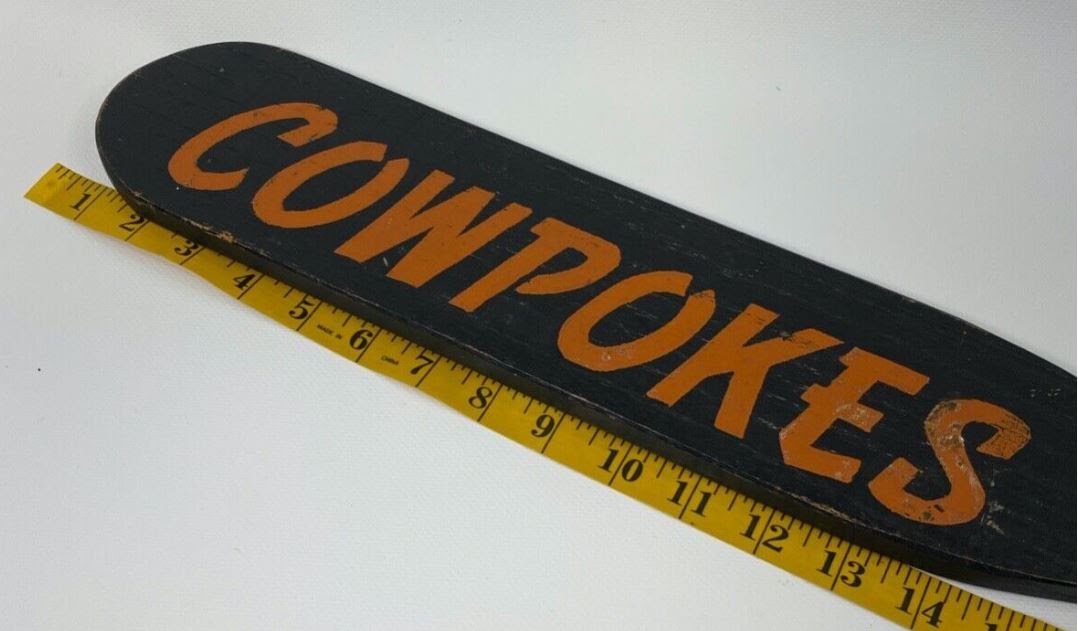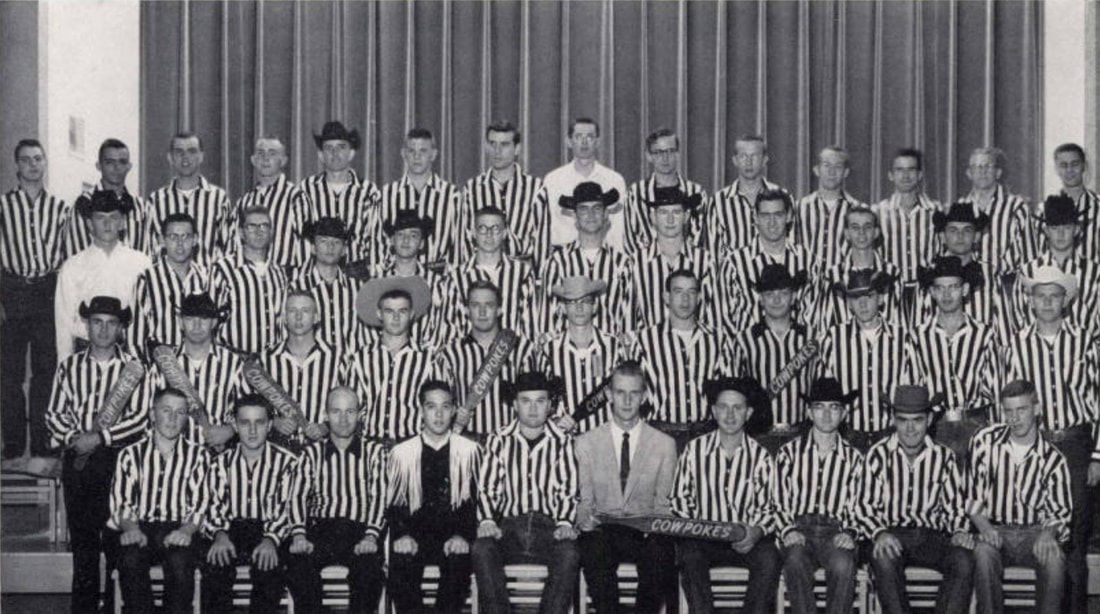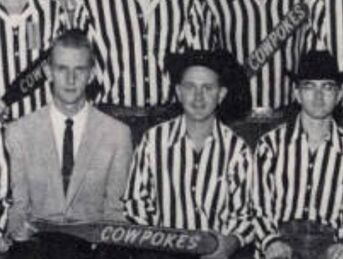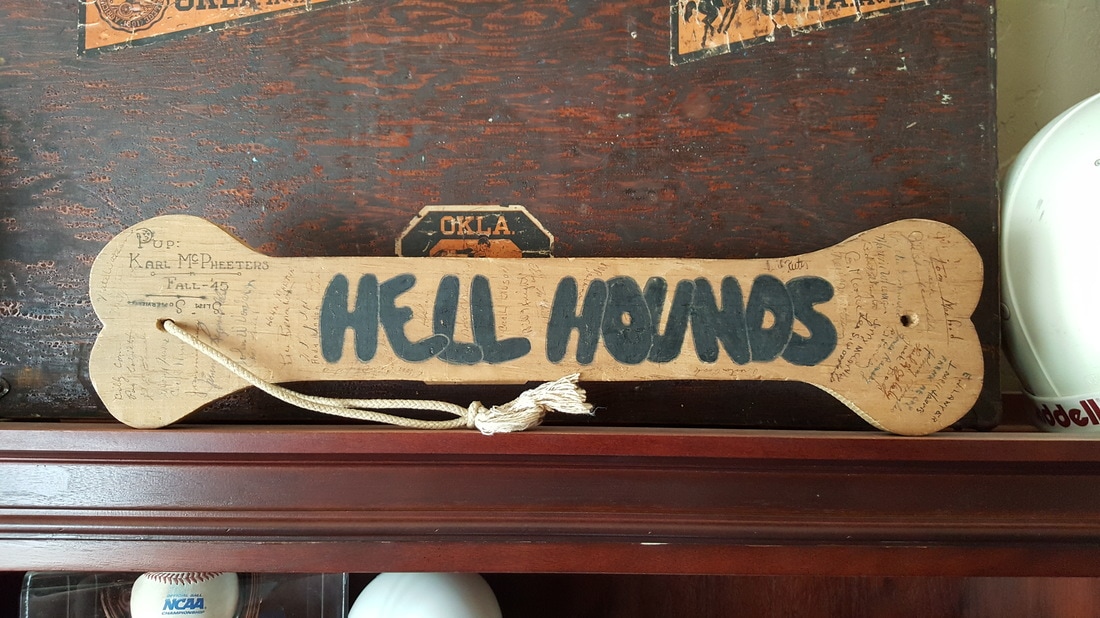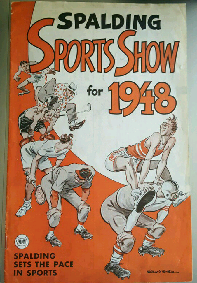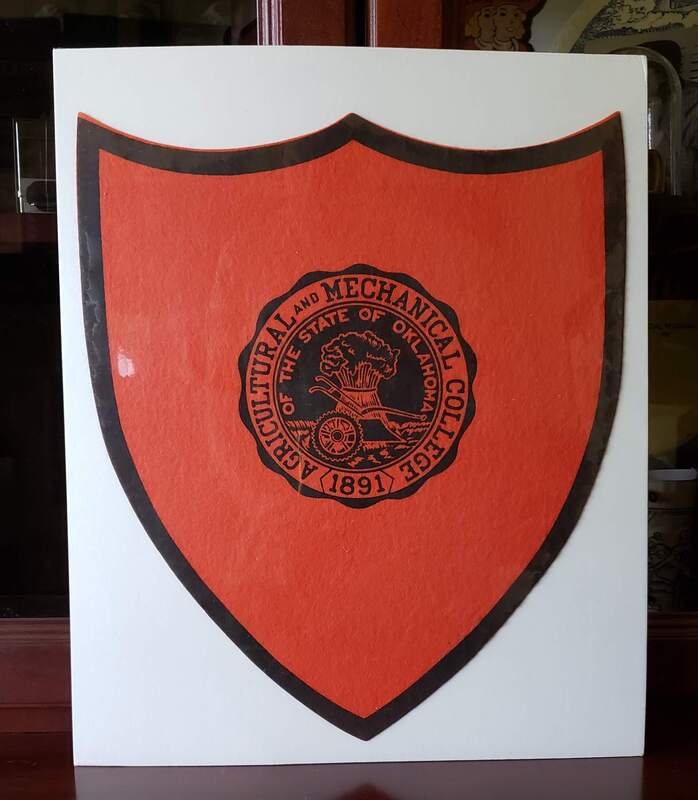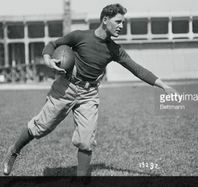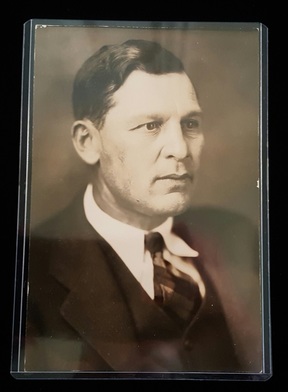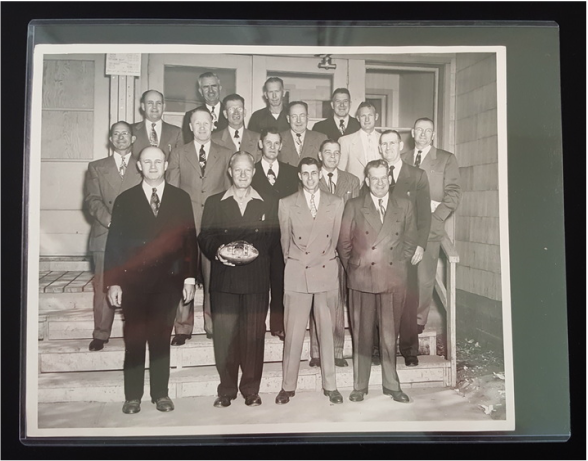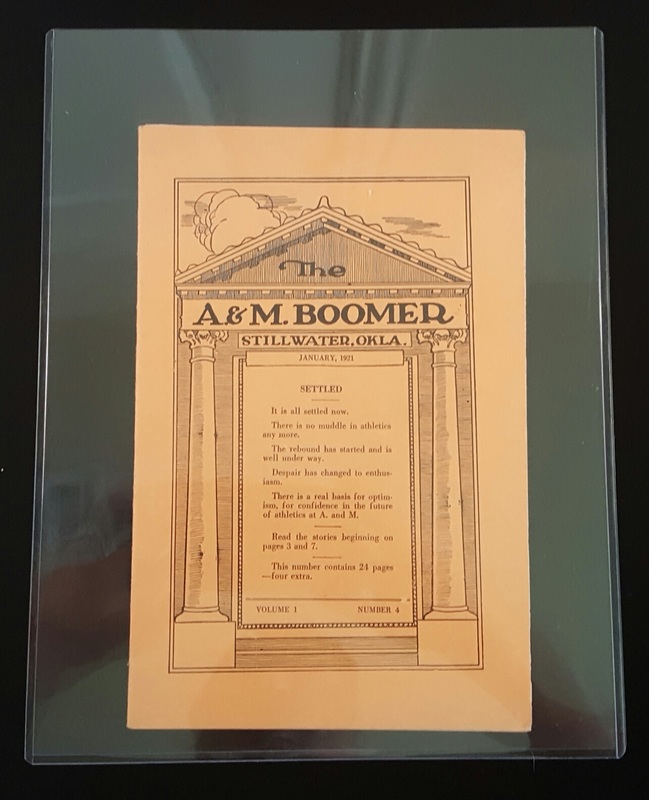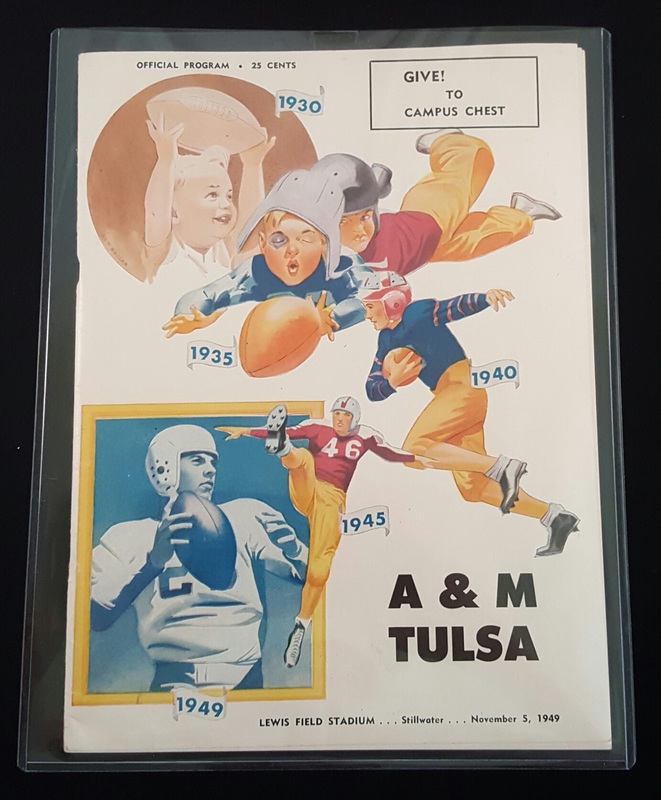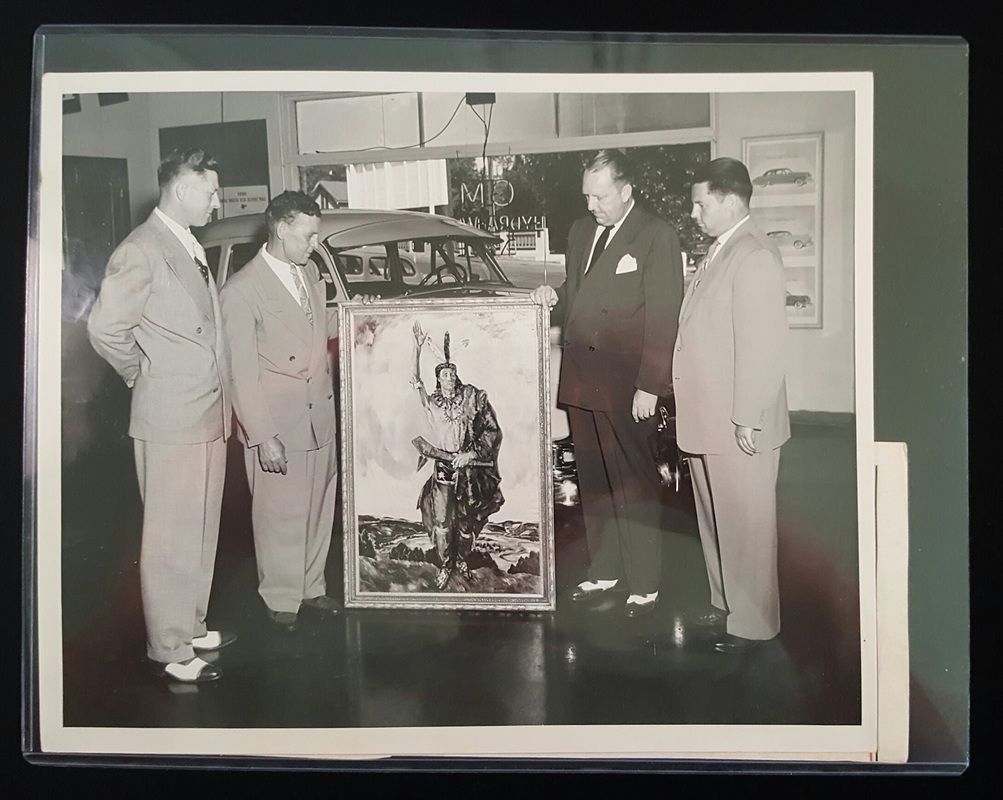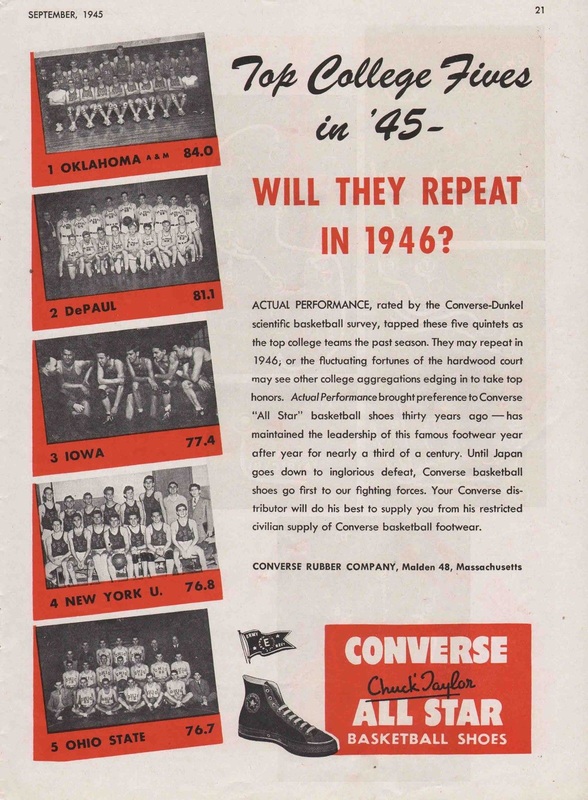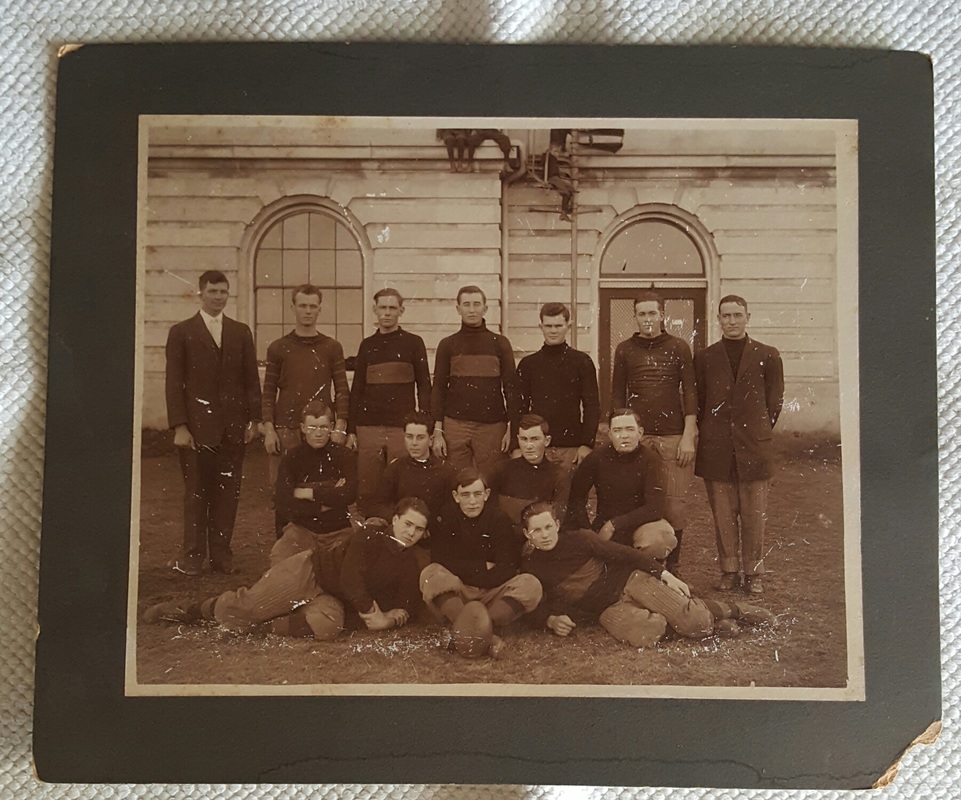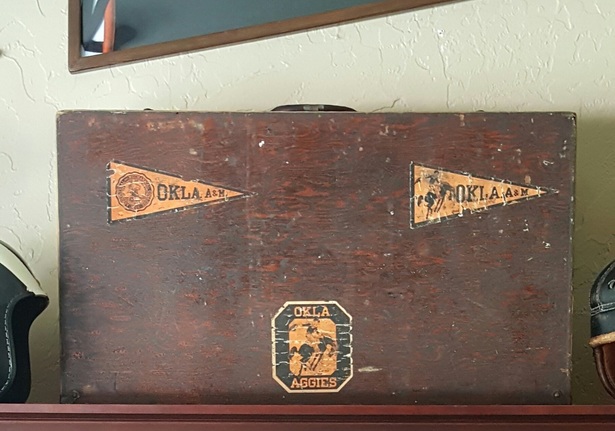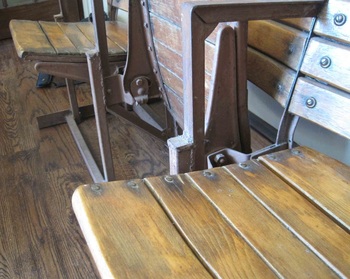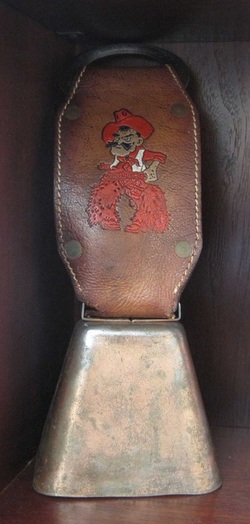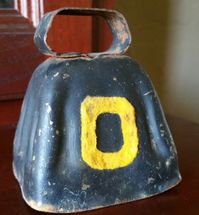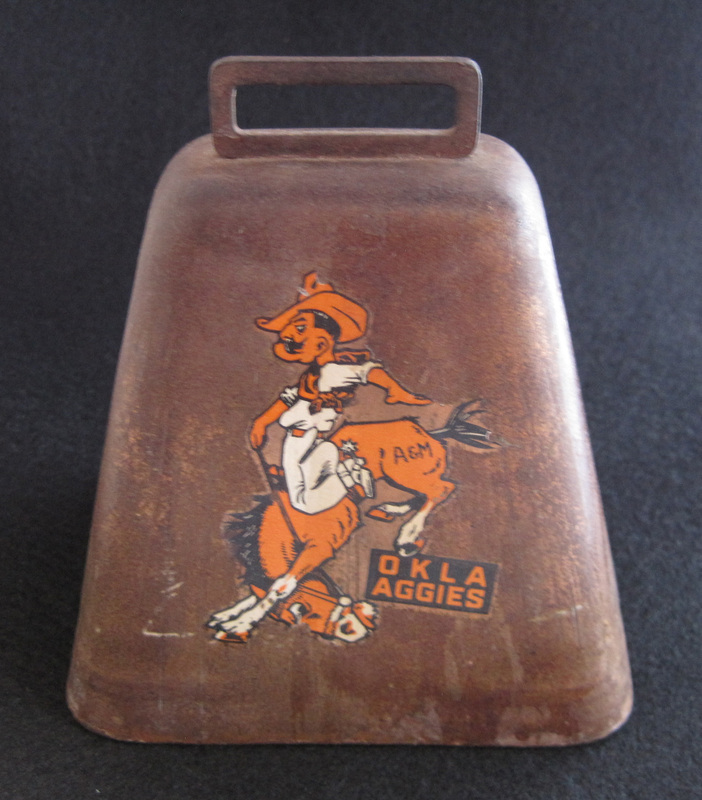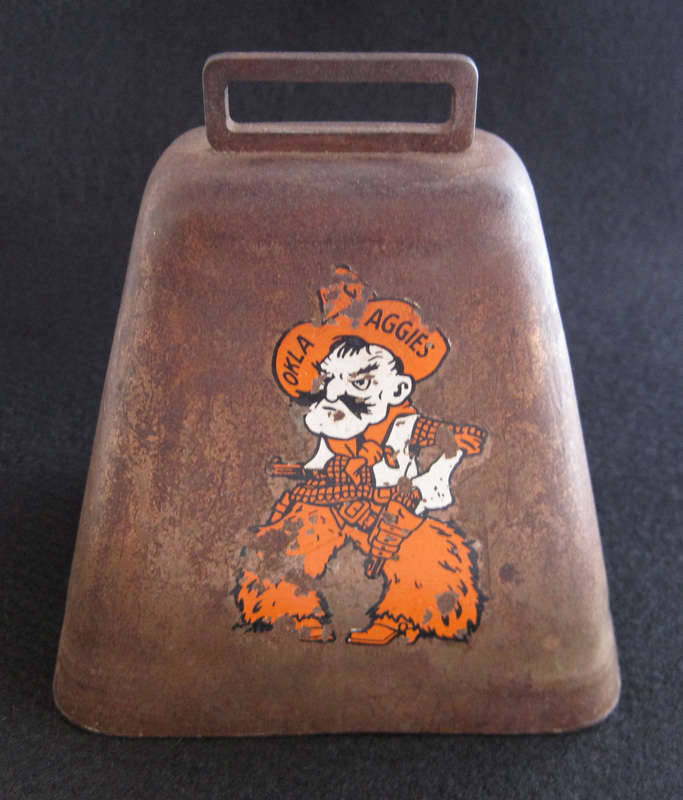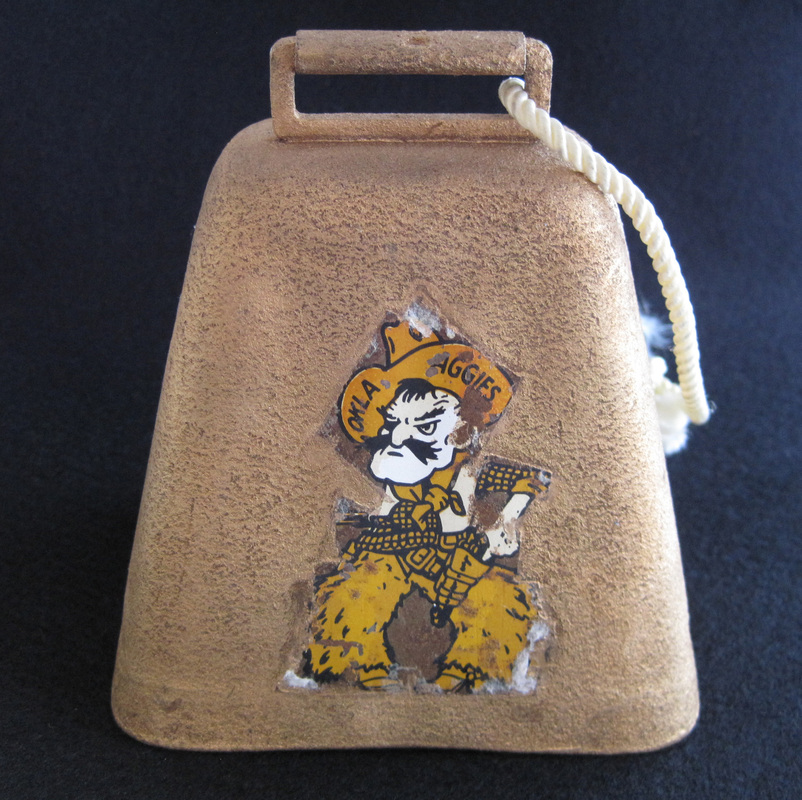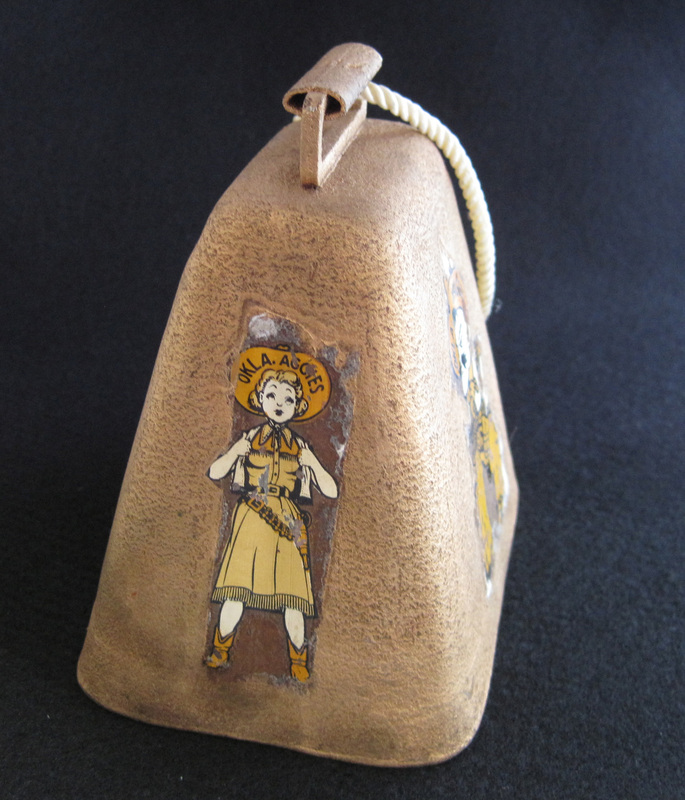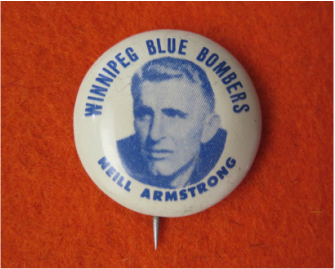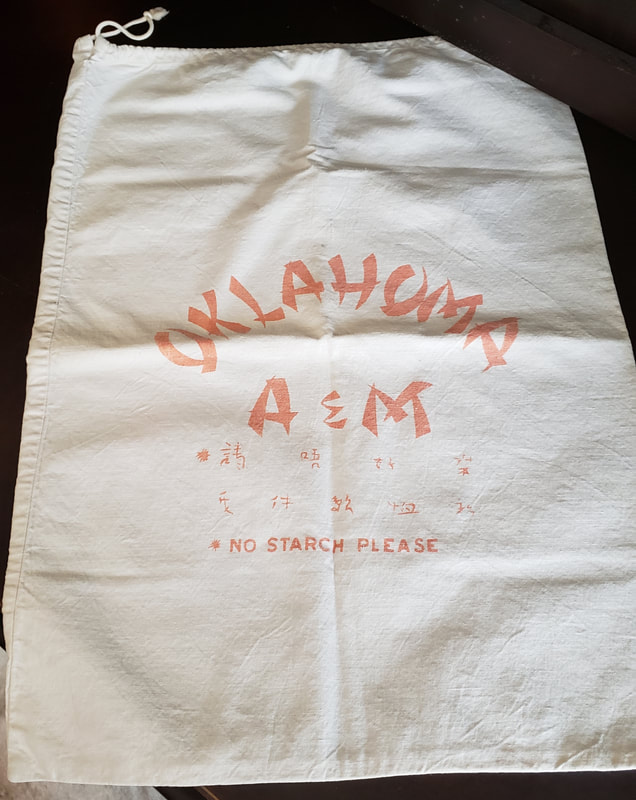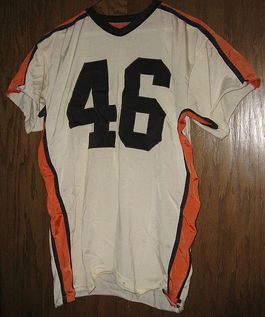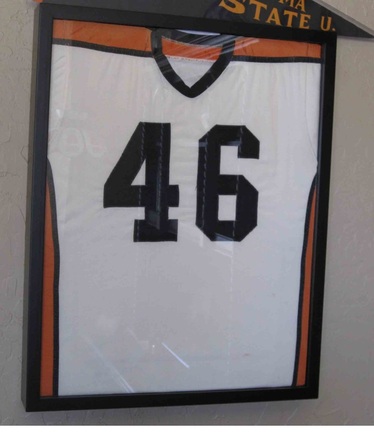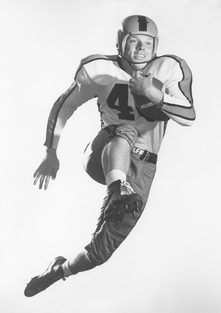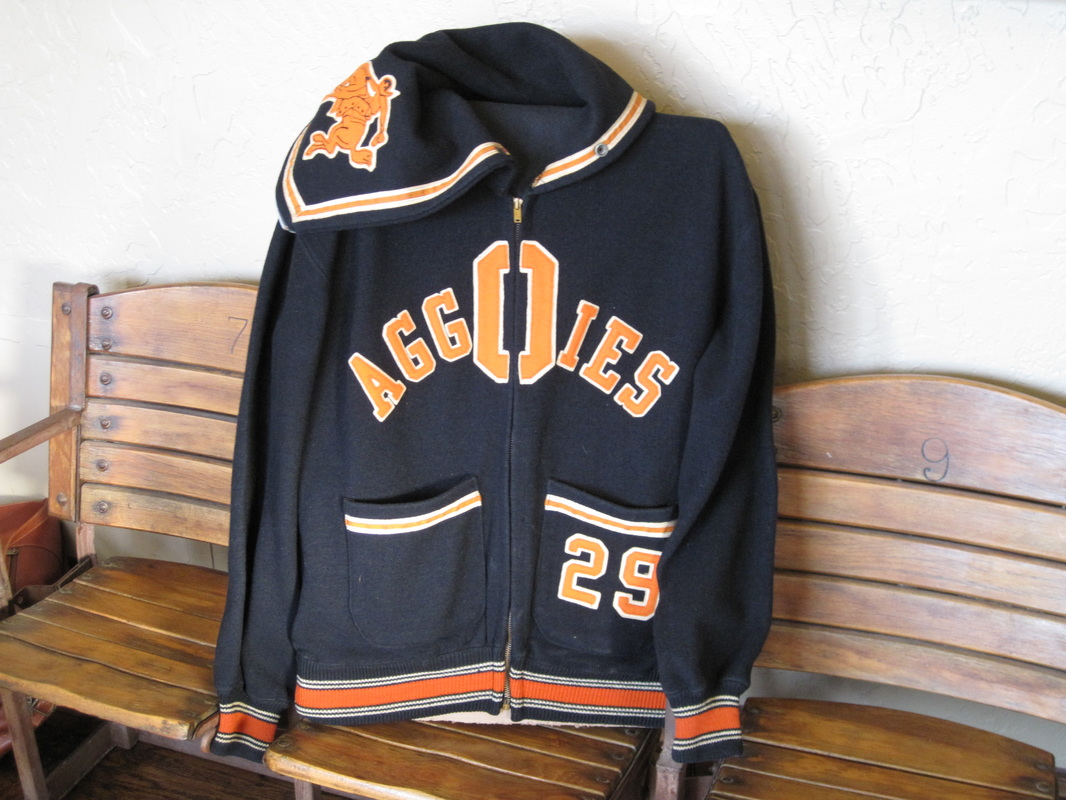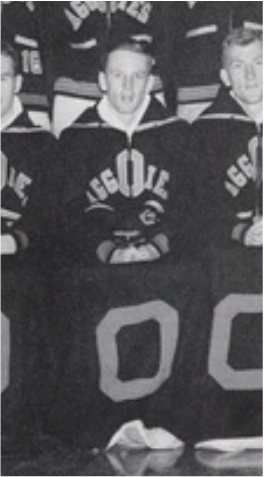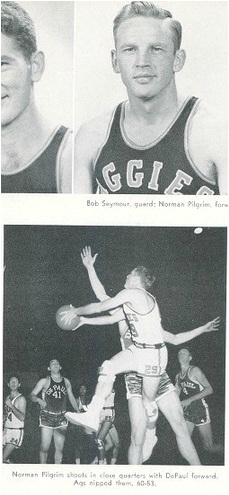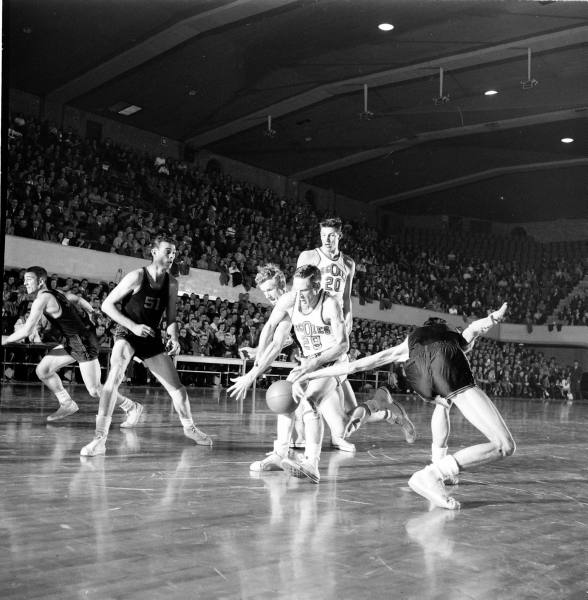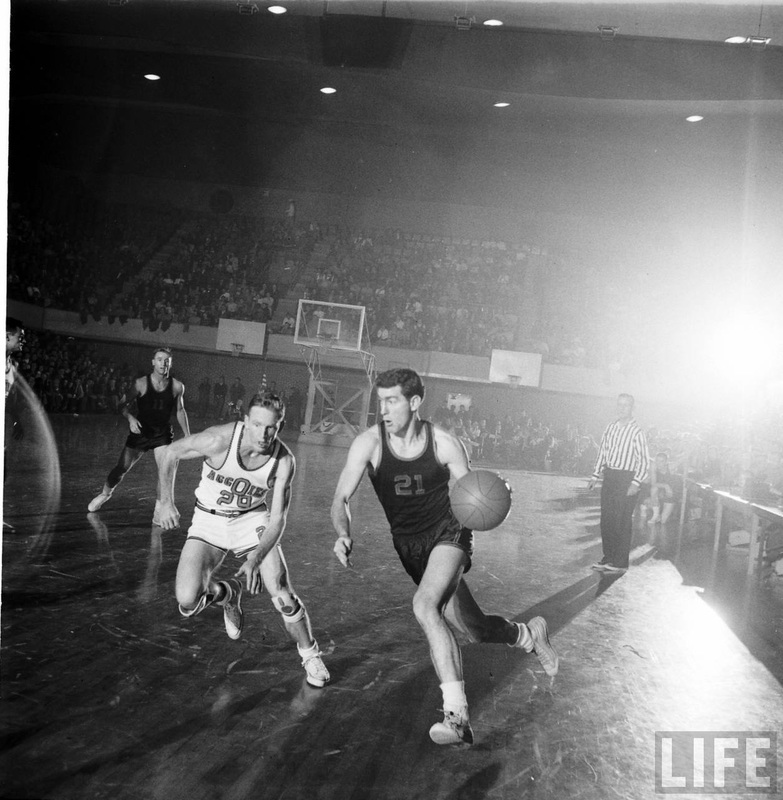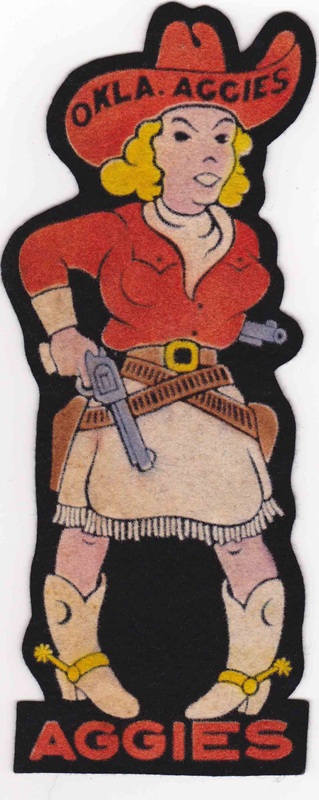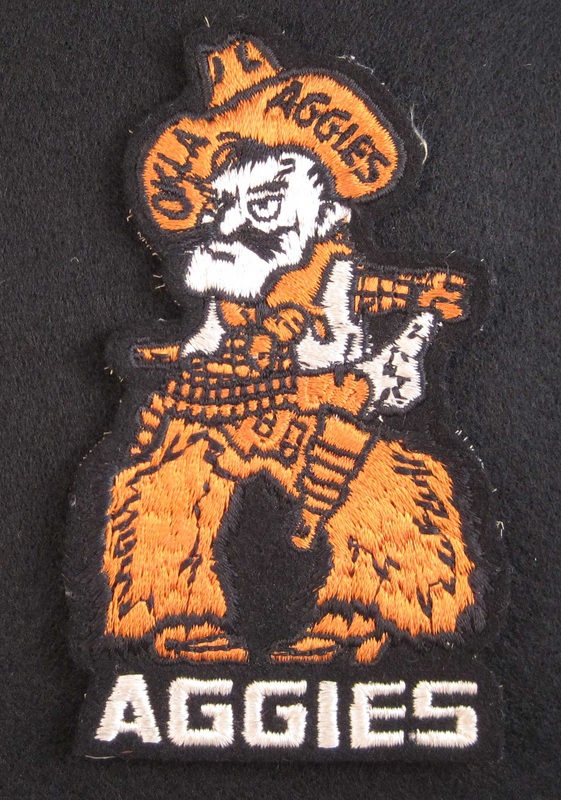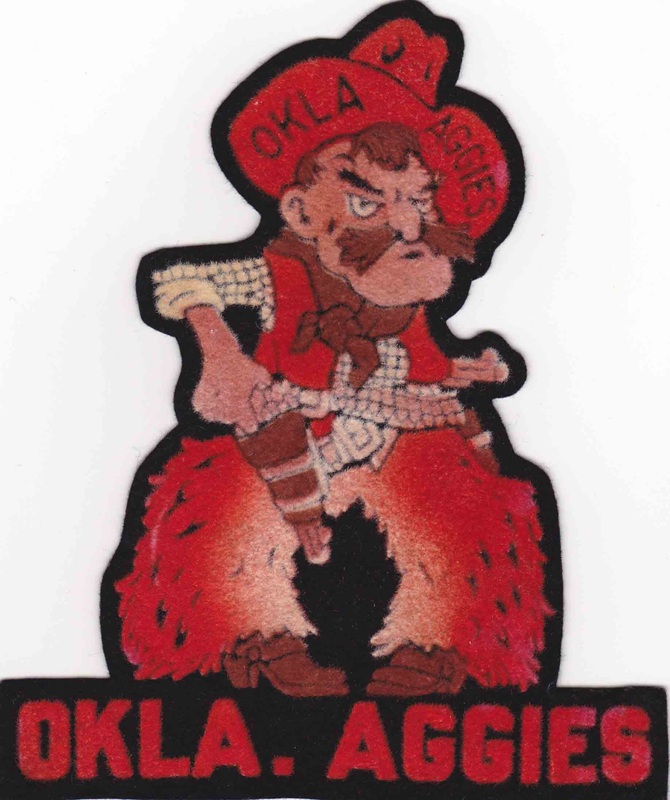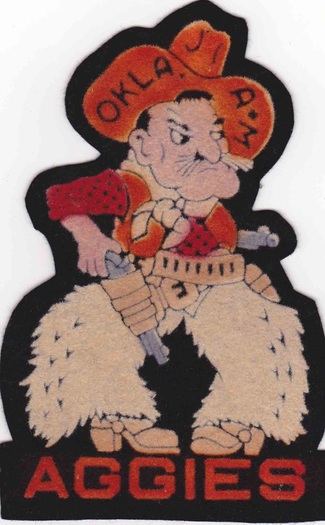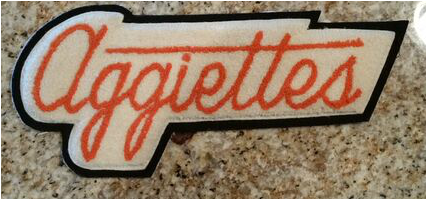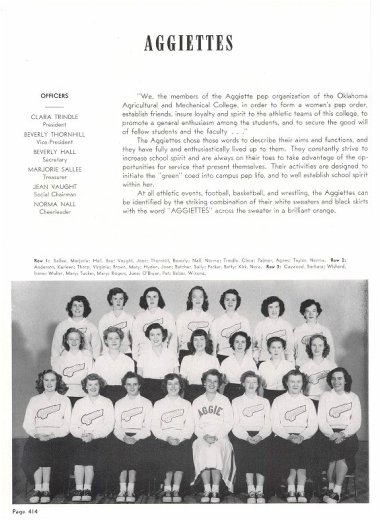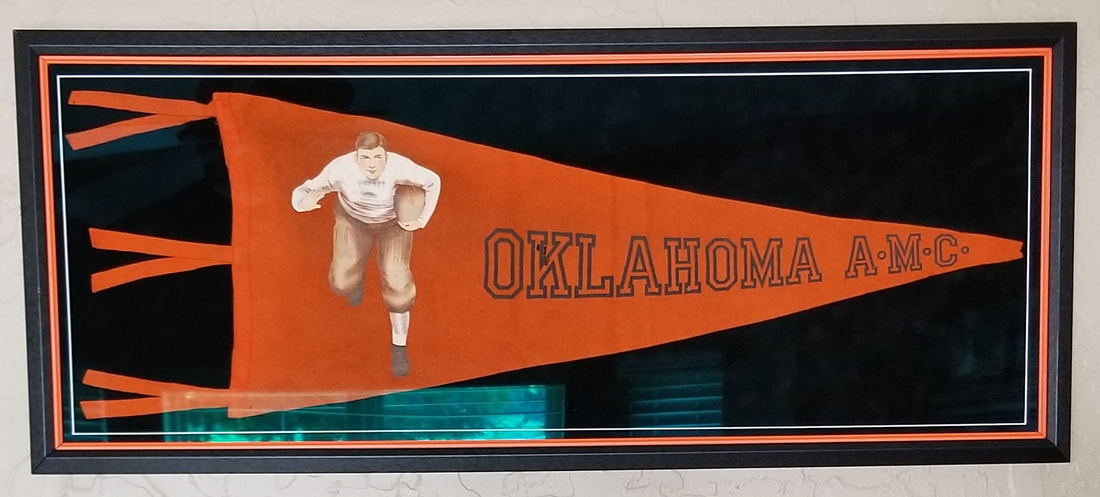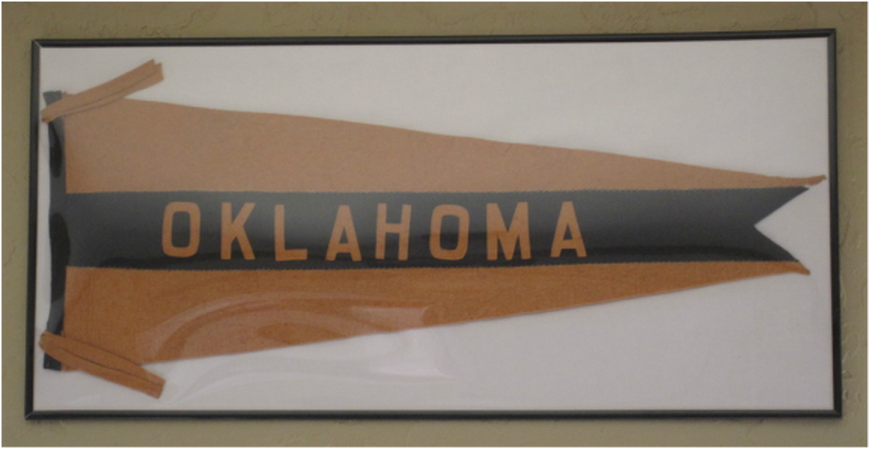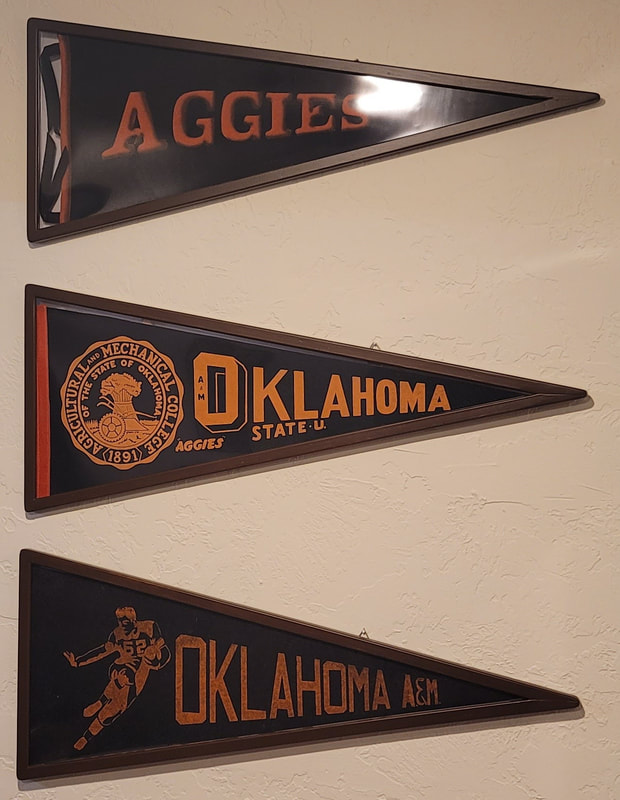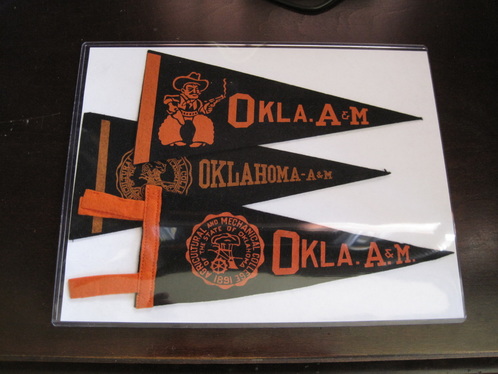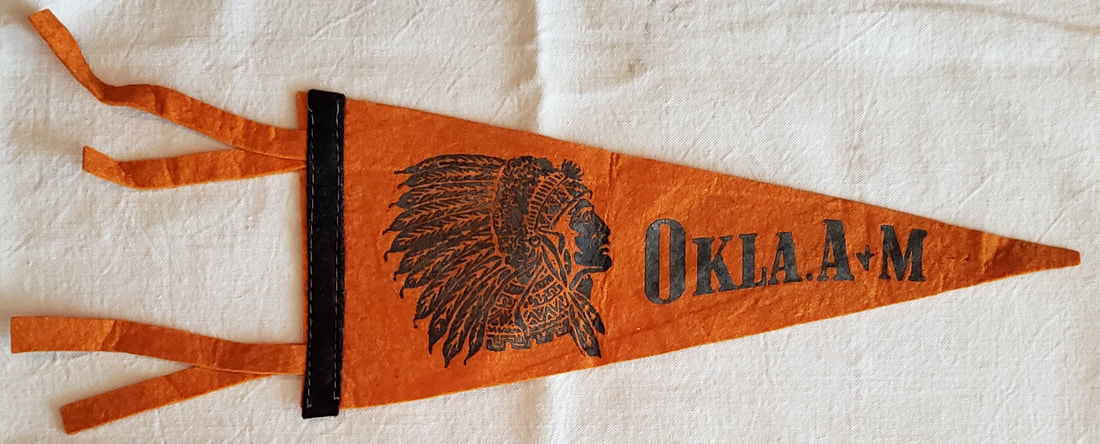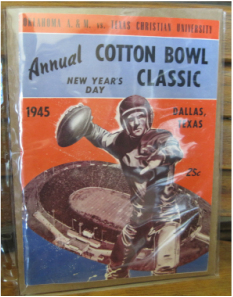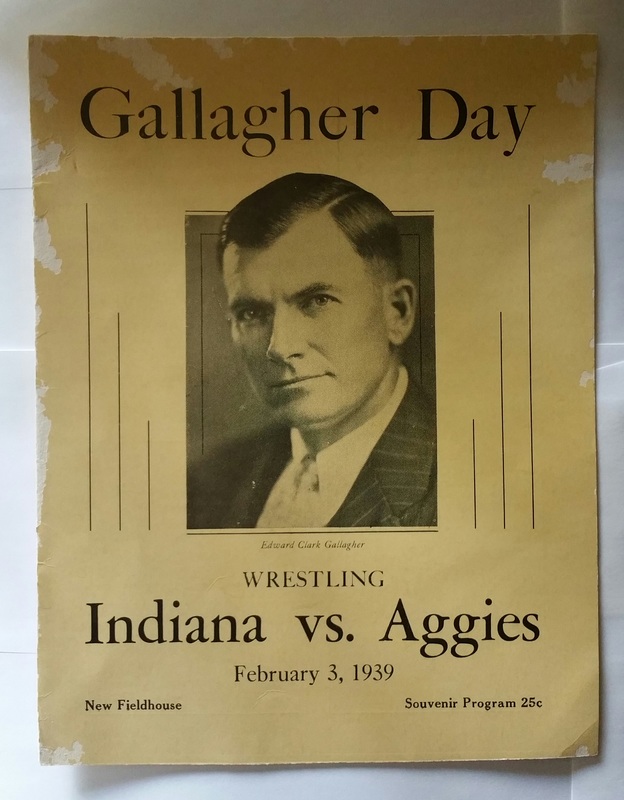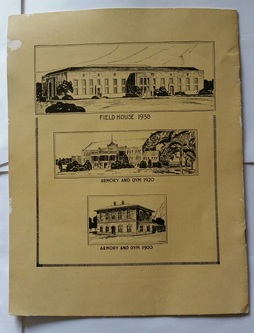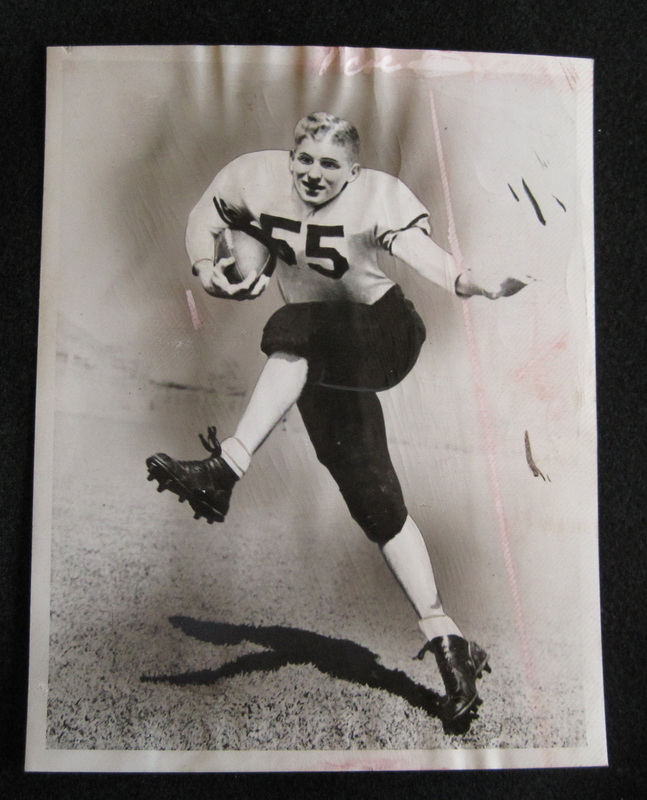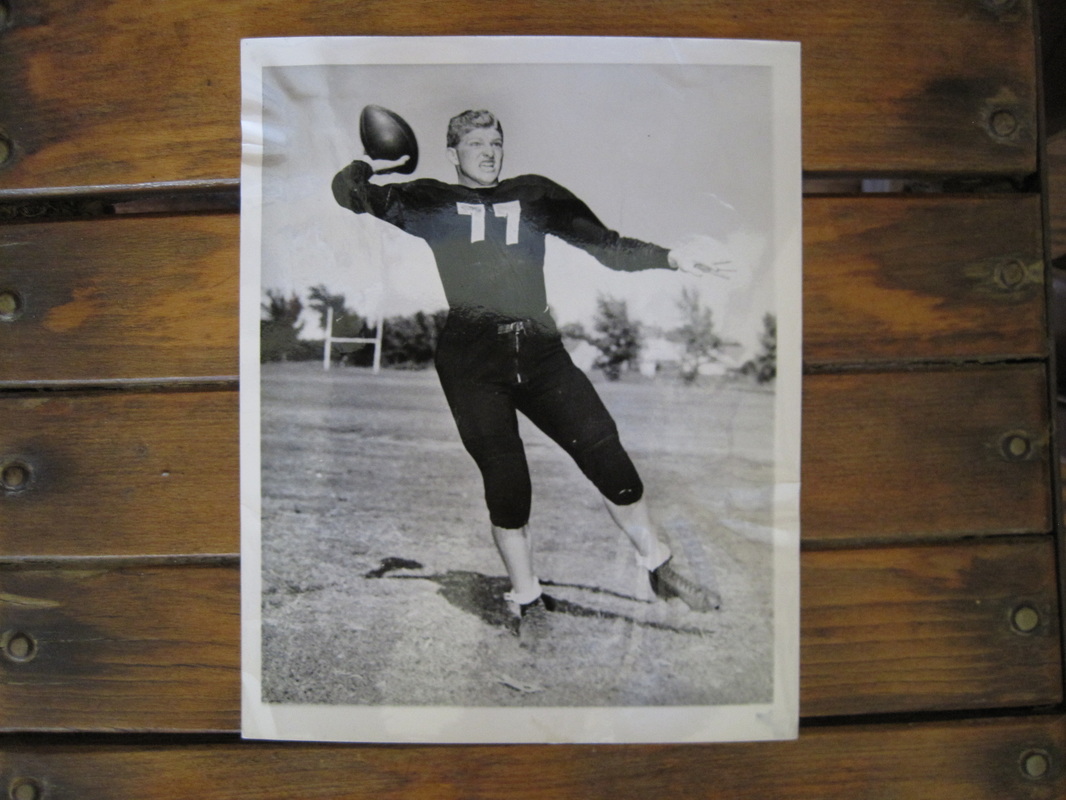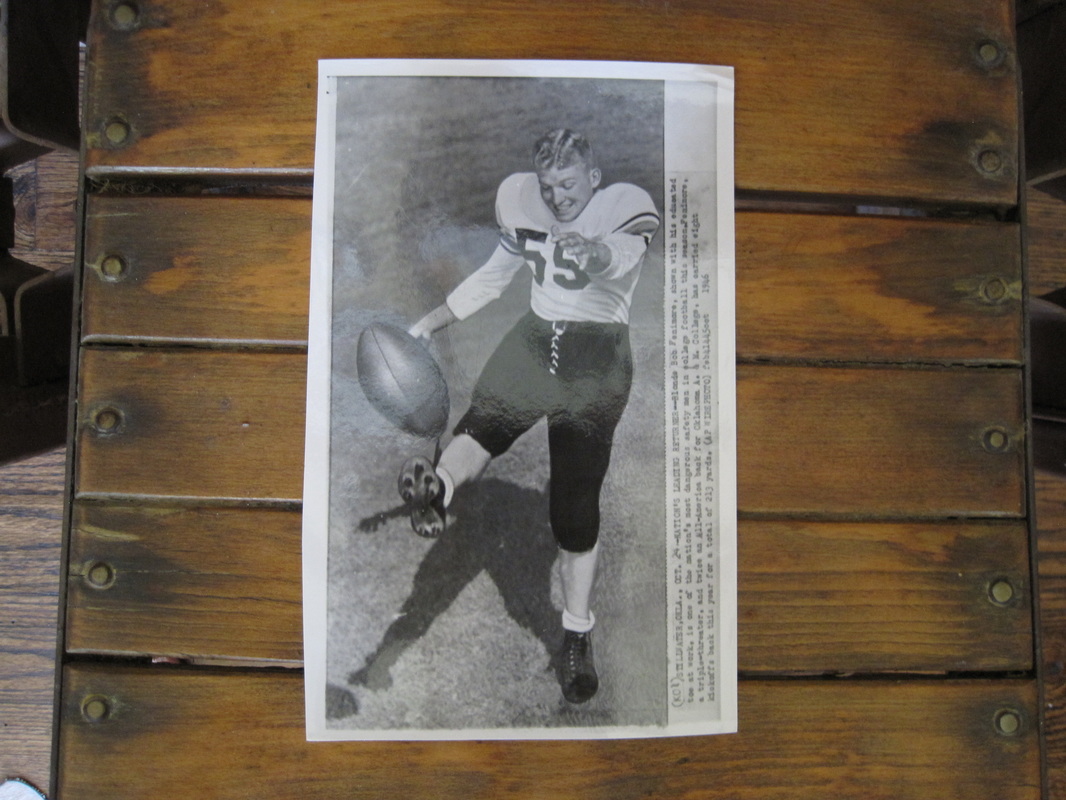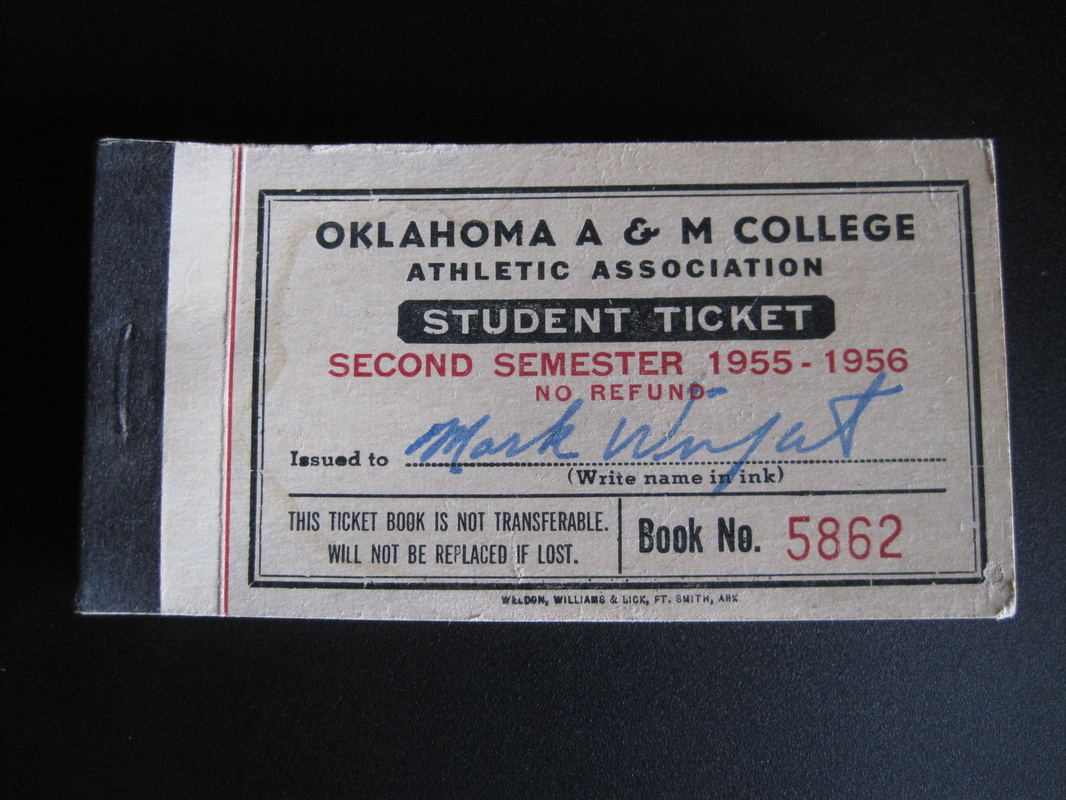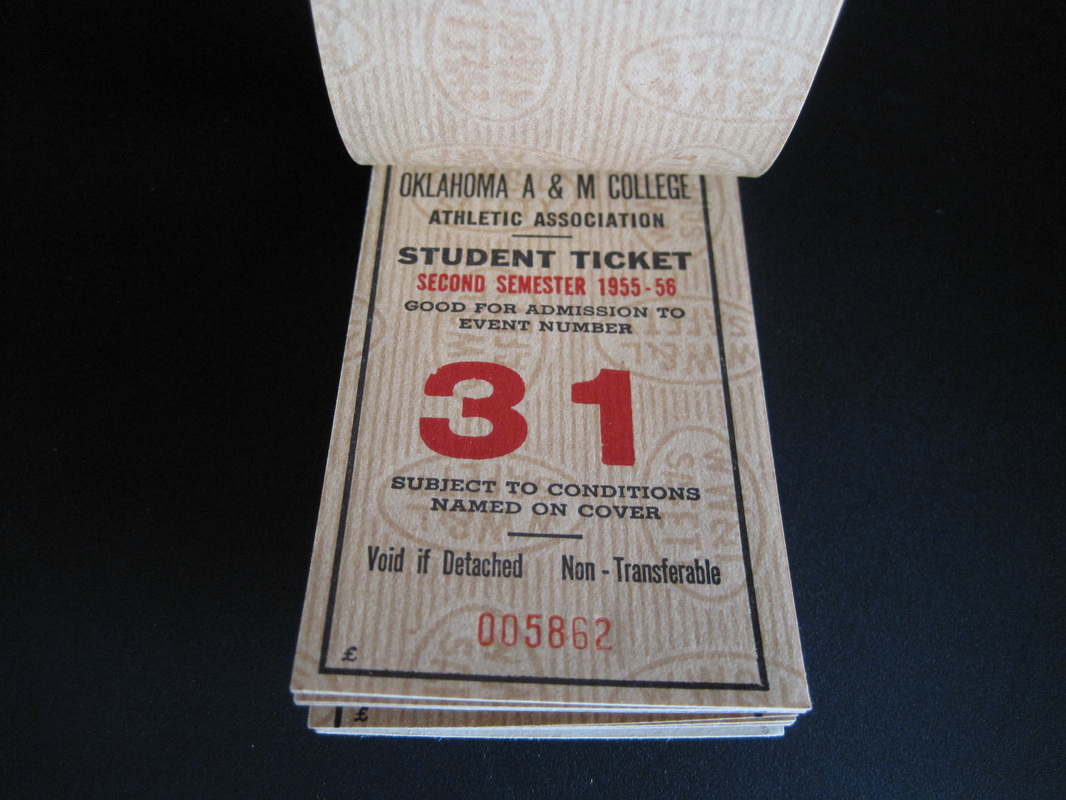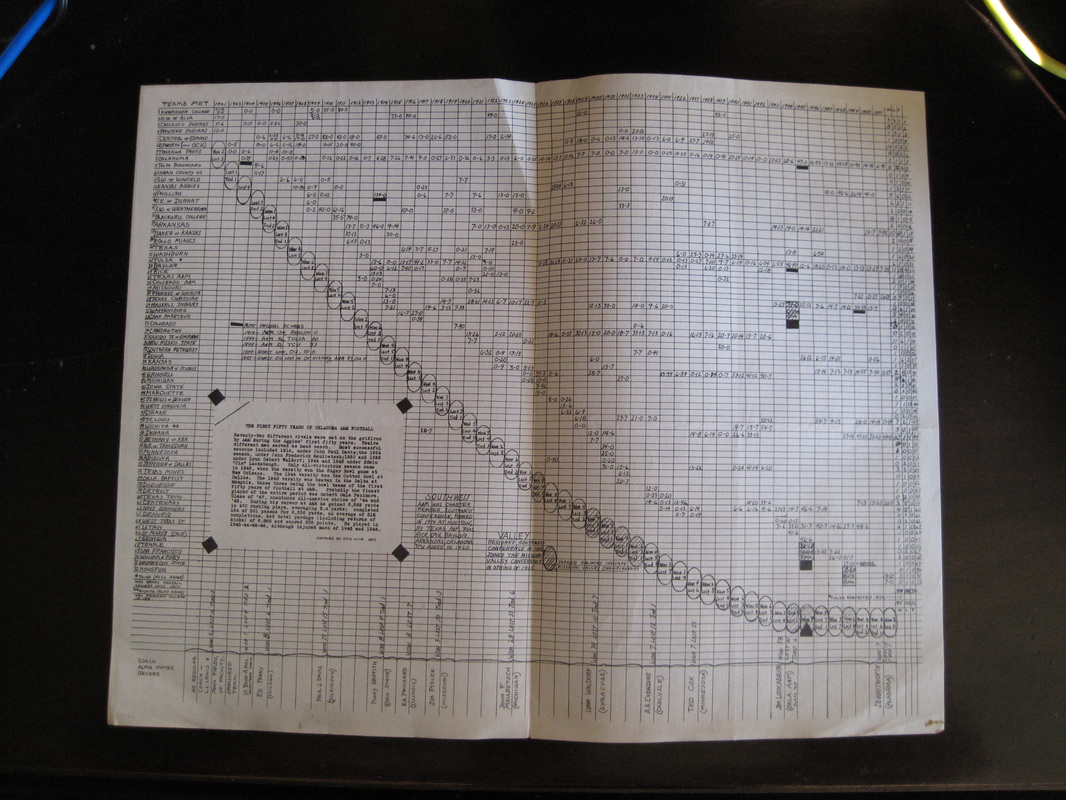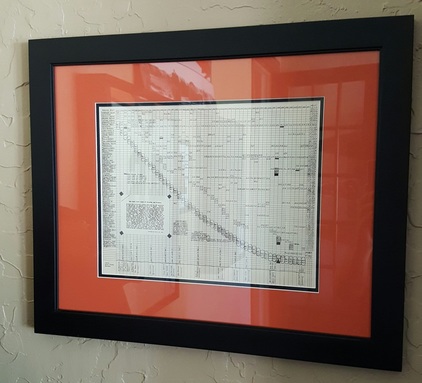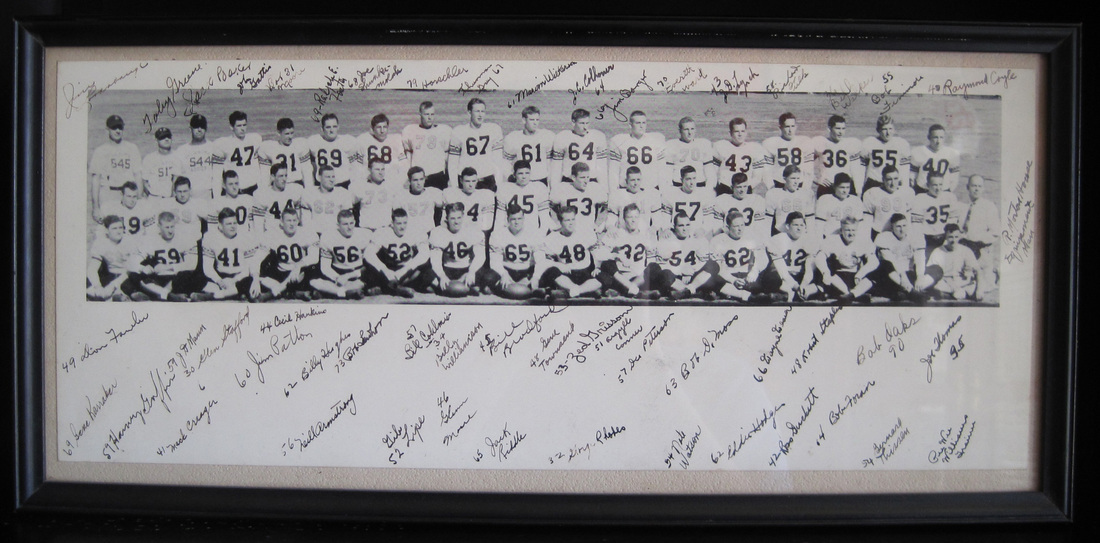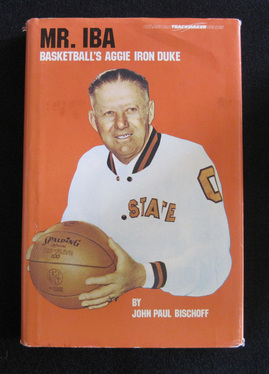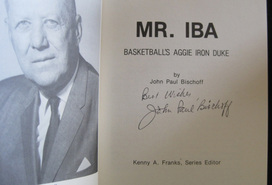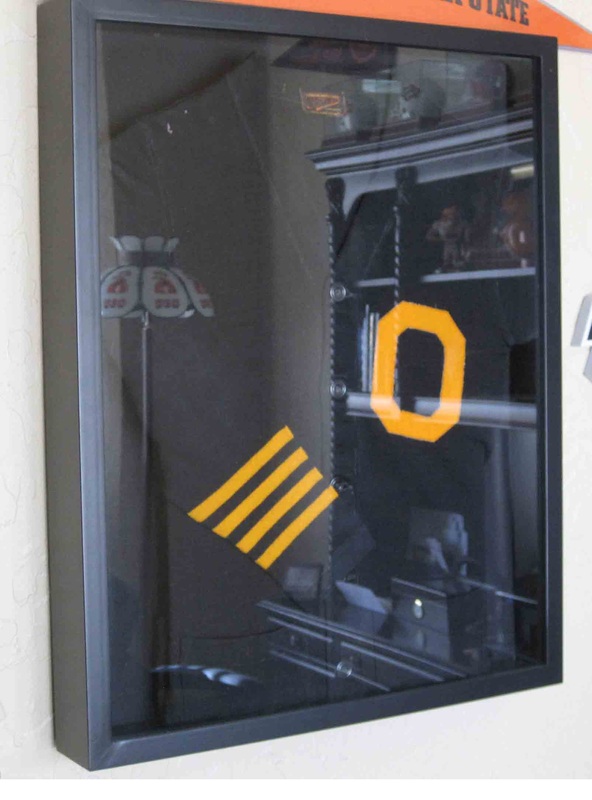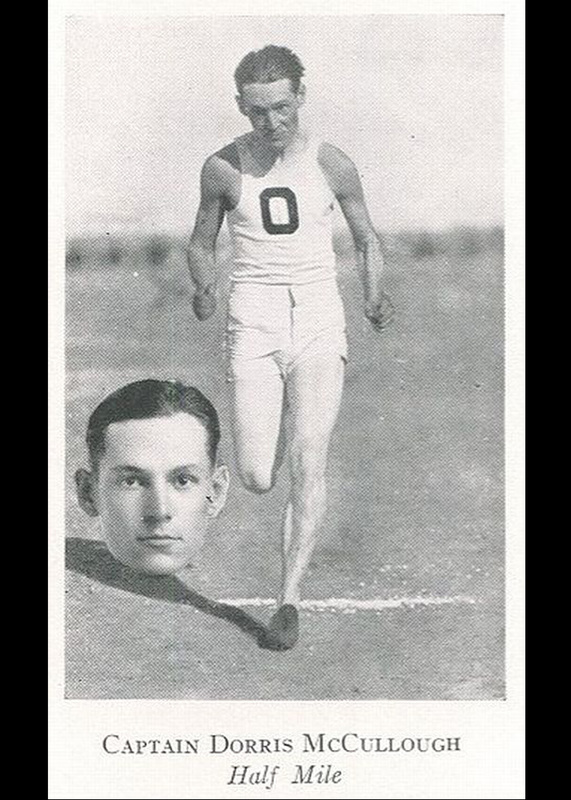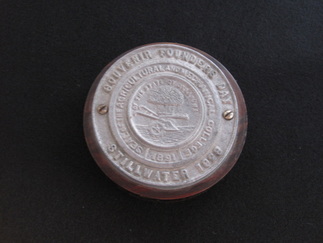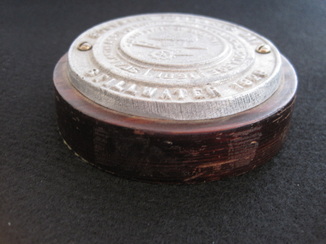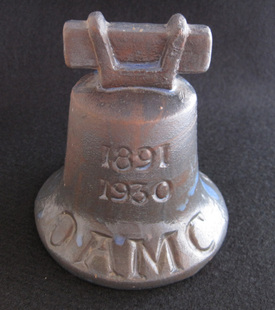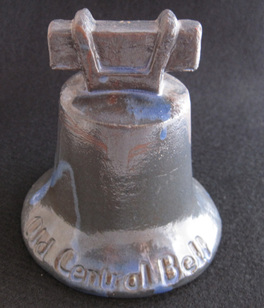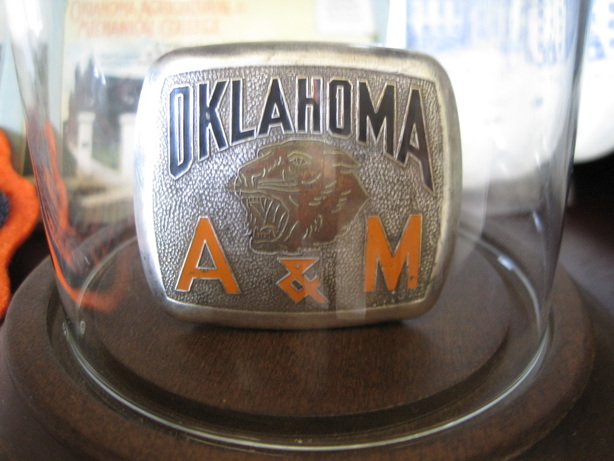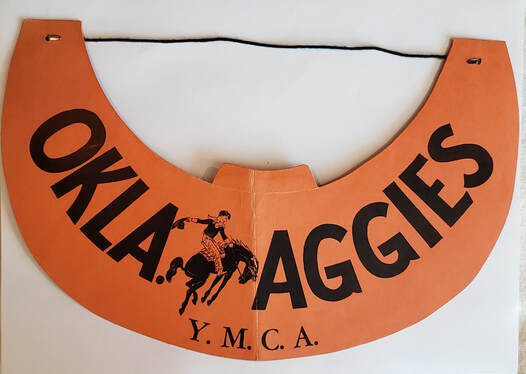
Gameday sunshade for those hot Lewis Field afternoons.
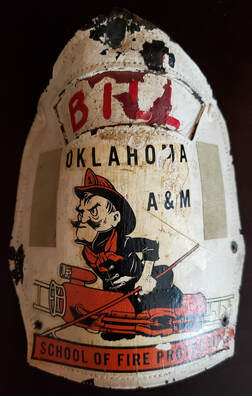
Oklahoma State's Fire Protection school has a long history and is known as one of the best in the country. This is the leather front panel of an OAMC fireman's helmet.
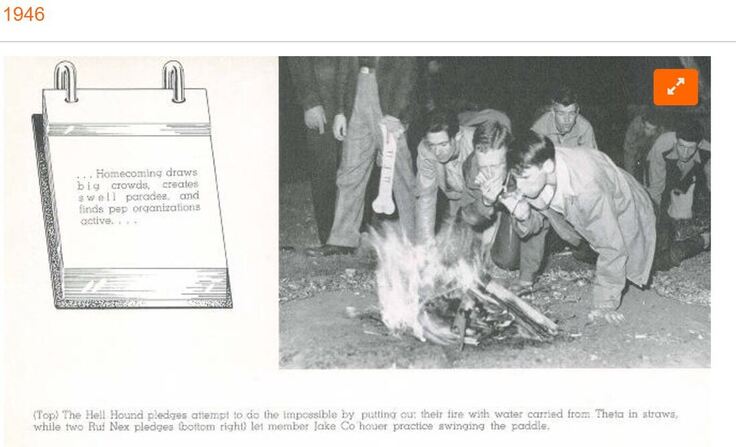
1945 "Hell Hounds" dogbone paddle. Signed by 72 members of the Hell hounds pep group, including several football players, most notably star Neill Armstrong.
1948 Spalding Sports Show publication
Including Oklahoma Aggie cartoon
18" tall vintage felt banner/crest
John Maulbetsch Collection
|
Context: I've been in contact with a University of Michigan collector for some time now. Recently, he very generously donated his impressive UM collection to the university library archives. He was incredibly generous to me as well, entrusting me with the Oklahoma A&M-related items from the collection. Not only are they great memorabilia, everything in this section came from the John Maulbetsch estate and were Maully's own personal items.
|
|
Brief bio:
John F. "Johnny" Maulbetsch (June 20, 1890 – September 14, 1950) was an All-American football halfback at Adrian College in 1911 and for the University of Michigan Wolverines from 1914 to 1916. Maulbetsch became one of the most famous American football players in 1914 while playing for the University of Michigan. Maulbetsch became known as the "Human Bullet" because of his unusual low, line-plunging style of play. He has been inducted into the College Football Hall of Fame, and the University of Michigan awards the John F. Maulbetsch Award each year. In January 1921, Maulbetsch was hired as the head coach at Oklahoma Agricultural and Mechanical College (now Oklahoma State) in Stillwater, Oklahoma. He served as the coach at Oklahoma A&M from 1921 to 1928, where he was OAMC's coach in football, baseball, and basketball. Source and complete Wiki bio: https://en.wikipedia.org/wiki/John_Maulbetsch |
5 x 7 original portrait
|
The above "The Orange and Black" Sports Extra from January 15, 1921, which was mailed to Maulbetsch at his home near Phillips University where he was coaching at the time. The Oklahoma A&M college newspaper published a special edition featuring the arrival of John Maulbetsch as the new head football coach. For OAMC to draw a person of Maully's fame was indeed big news and the campus was ecstatic.
Maulbetsch's autograph book from the 25th year reunion of his 1924 team, which was the most successful squad over the first several decades of OAMC's football program, posting a 6-1-2 record and a win over rival OU. Many notable names from early OAMC athletics.
Group photo from the above-mentioned 1949 reunion. Notable men pictured include Maulbetsch (center), OAMC head football coach and former player Jim Lookabaugh (top row, with tie), and Ralph Higgins (right side, lightest suit) who was the fastest player on this team, 32 year legendary track coach at OSU and 2 time US Olympic track coach.
Saved correspondence related to Maulbetsch's time coaching OAMC.
The Daily Oklahoman sports section 11/28/1926. Features include a full page celebrating the Aggies' Missouri Valley Conference Championship, their first. Includes the All-Conference selections of two Aggies: Harold Weissinger at guard and Gordon Peery at quarterback. (Picture #'s 8 and 9, wearing helmets).
November 20, 1927 Daily Oklahoma Sports Section featuring one of the most important wins of Maulbetsch's tenure over rival Oklahoma.
January 1921 A&M Boomer, which was an early alumni publication, providing updates on former students at a time when that was a manageable number. This 4th issue was extended and devoted largely to Maulbetsch, his gridiron exploits, and his celebrated arrival on OAMC's campus.
Maulbetsch's program from the 1949 game during which the team reunion (pictured above) took place.
September, 1945 Converse advertisement ranking the Aggies #1.
The last two sentences: "Until Japan goes down to inglorious defeat, Converse basketball shoes go first to our fighting forces. Your Converse distributor will do his best to supply you from his restricted civilian supply of Converse basketball footwear."
The last two sentences: "Until Japan goes down to inglorious defeat, Converse basketball shoes go first to our fighting forces. Your Converse distributor will do his best to supply you from his restricted civilian supply of Converse basketball footwear."
1912 Freshman Football Team
Original 8 x 10 photo; writing on the back reads "Ball game at the college".
In my research, I have identified this as the Freshman football team from 1912-1913. In those days, Freshman were not allowed to play on the varsity squad, instead playing games against the Sophomores, the Business College, and other intramural matches. They are pictured here standing outside of Morrill Hall (Which burned a few months after this was taken).
Identified players:
Carl Weaver (back row, 3rd from right). Carl lettered as QB and Kicker on the Varsity team the 3 following years, and was one of A&M's first football "stars", of statewide acclaim.
Cecil Hueston (middle row, 2nd from left) excelled in track during his subsequent years at OAMC.
I am still working to identify the rest of the players as well as coaches, but the roster was as follows:
Halfbacks - Weaver and Scott
Fullback - Bonar
Ends - Hueston and Ellison
Quarters- Byars and Dalton
Offensive Tackles - Rouse and Hicks
QB- Caton
Center - Mann
Defensive Tackles - Cordell and Neff
Position unknown - Shorty Morgan
Note the children on the fire escape photobombing the team picture.
In my research, I have identified this as the Freshman football team from 1912-1913. In those days, Freshman were not allowed to play on the varsity squad, instead playing games against the Sophomores, the Business College, and other intramural matches. They are pictured here standing outside of Morrill Hall (Which burned a few months after this was taken).
Identified players:
Carl Weaver (back row, 3rd from right). Carl lettered as QB and Kicker on the Varsity team the 3 following years, and was one of A&M's first football "stars", of statewide acclaim.
Cecil Hueston (middle row, 2nd from left) excelled in track during his subsequent years at OAMC.
I am still working to identify the rest of the players as well as coaches, but the roster was as follows:
Halfbacks - Weaver and Scott
Fullback - Bonar
Ends - Hueston and Ellison
Quarters- Byars and Dalton
Offensive Tackles - Rouse and Hicks
QB- Caton
Center - Mann
Defensive Tackles - Cordell and Neff
Position unknown - Shorty Morgan
Note the children on the fire escape photobombing the team picture.
Handmade wooden trunk with old OAMC decals.
Large metal trunk with military stenciling and Oklahoma A&M decals.
Seats from the original Gallagher Hall, 1938. One of the best pictures of these seats in Gallagher Hall is the Hillyard advertisement on this page. OSUs Heritage Hall sports museum also houses a set of these chairs.
Cowbells
As was the case with many land-grant agricultural universities, from the early days at Oklahoma A&M and into the 80s at OSU, it was a tradition to bring cowbells to sporting events. Fans would show their enthusiasm with bells brought from their farms to cheer on their sports teams. The Big 12 no longer allows these "artificial noisemakers" at games, so these decorated relics are a glimpse into the past.
|
1950's pin featuring Neill Armstrong, Class of 1946 and letterman in 3 sports at OAMC. Drafted 8th overall in 1947, he won 2 NFL Championships with the Philadelphia Eagles before playing for the CFL Winnipeg Blue Bombers where he was a two-time All Star. He went on to become a coach for over 3 decades, including 4 years as Head Coach of the Chicago Bears.
|
Oddball OAMC Chinese laundry bag
Early 1950's football jersey, obtained from a former Oklahoma A&M player. Sleeves were likely cut off after game use so it could continue to be used as a practice jersey.
|
Basketball warmup of Norman Pilgrim. In 1951, Coach Henry Iba said 5'10" 165lb Pilgrim was "one of the best little men in the game today" (O'Collegian 3/16/51). The Stillwater native was named Honorable Mention All-Missouri Valley in 1950 and 1st team All-Missouri Valley in 1951. "Little Norm" went on to be the head coach of the gold-winning USA basketball team at the 1955 Pan American Games.
|
Vintage Patches
|
In 1932, it was determined that the university could support another pep organization, so 5 girls formed the Aggiettes as a female counterpart to the existing Ag-He-Ruf-Nex men's organization. Professor Valerie Colvin of the Physical Education Department was instrumental in sponsoring the new group. For most of the organization's life, a limited number of members were selected from different campus dorms and sororities and were pledges who had to demonstrate their dedication to OAMC before being awarded the Aggiette sweater.
After a 4 year absence during WWII, in 1946 the Aggiettes returned as an active group. They sponsored dances and fundraising events with their male pep counterpart Ruf-Nex. (Similarly, the other two campus pep groups, the Peppers and the Hell Hounds interacted as loosely defined coed "teams".) The Aggiettes wore sweaters with this patch from 1947 until their final year in 1954. The following year, it was decided to combine the female spirit organizations, thus the Peppers and the Aggiettes became the "Pepperettes". |
Oklahoma A&M Aggies - Vintage Pennants
Dating around 1910, oversized 40" pennant featuring early football player with reeded pants and melon-style football. To put this in perspective, this was before wearing helmets was common and before Lewis Field had its first bleachers.
Approximately 1910-1915 "fishtail"pennant. 36 inches long, stitched orange and black panels and appliquéd lettering
(Left) Leather bucking horse patch
Aggies player with "dog ear" style leather helmet, which was popular in the 1920s. In the early 1900's, OSU teams were often referred to as simply "Oklahoma Aggies".
Pennant from 1946 Sugar Bowl. OAMC defeated St. Marys 33-13 prompting the Gaels' coach Jim Phelan to comment "Too much power - too much speed. And, above all, too much Fenimore."
Mini Pennants (Approx. 9 inches)
Unusual antique Indian pennant.
Paper Ephemera
1945 Media Guide
|
February 1939 Gallagher Day program. Original program from the first wrestling match in the new "4H Club and Student Activities Center" which would be renamed Gallagher Hall, and later Gallagher-Iba Arena. Contains biographical information on Gallagher as well as proud details of the new building, "The Madison Square Garden of the West", among them the basketball floor "built of white maple an inch and a quarter thick, and is the heaviest, largest, most expensive basketball floor in the nation"
|
|
1945 newspaper wire photo of A&M All-American Bob Fenimore. One of the more iconic images of the "Blonde Bomber"; the International News Syndicate text attached to the back notes that this was taken as the #5 Aggies prepared to play #7 St. Marys in the Sugar Bowl on New Years Day in 1946. After leading the nation in total offense for the second straight year, Fenimore led OAMC to the 33-13 win, rushing for 125 yards and 2 TDs and passing for another touchdown.
|
Signed 20" team photo of/by the undefeated 1945 Cotton Bowl team, including OAMC greats Bob Fenimore and Neill Armstrong. Every player, coach, and trainer autographed this. Something I am very honored to own and have had the pleasure of sharing it with the families of several players on this team.
Aggie Decals
Mr. Iba biography, signed by the author and Coach Iba, and inscribed to Dr. Robert Kamm, OSU's President from 1966-1977.
Small OAMC items
1923 letterwinner sweater. Stripes generally indicated the number of letters that athletes earned, so this is likely from his senior year. He earned letters multiple times in his time at OAMC, including being track team captain his senior year.
Founder's Day
On December 25, 1890,the Oklahoma Territorial legislature gained approval for Oklahoma Territorial Agricultural and Mechanical College, the land grant university established under the Morrill Act of 1862. Founder's Day was traditionally celebrated on the anniversary of this date.
At the end of the 1920's, Oklahoma A&M's original building, "Old Central" was failing structurally and there was a sentiment that funds would be better used to demolish Old Central and start new construction. However, OAMC's President Henry Bennett felt the need to preserve the campus building and fought to keep it.
From the book, "Dr. Henry G. Bennett as I knew him" by Berlin Chapman, 1955. "Dr. Bennett found means to restore Old Central, and the heart of Aggieland was just a little lighter. At the Founders Day reunion in 1929 paperweights made from wood in Old Central and capped with metal were given as presents to guests, of which I was one. The paperweights are sacred in the memory of loyal Aggies. They bear the college seal and these words: "Souvenir, 'Founders Day, Stillwater, 1929.""
From the book, "Dr. Henry G. Bennett as I knew him" by Berlin Chapman, 1955. "Dr. Bennett found means to restore Old Central, and the heart of Aggieland was just a little lighter. At the Founders Day reunion in 1929 paperweights made from wood in Old Central and capped with metal were given as presents to guests, of which I was one. The paperweights are sacred in the memory of loyal Aggies. They bear the college seal and these words: "Souvenir, 'Founders Day, Stillwater, 1929.""
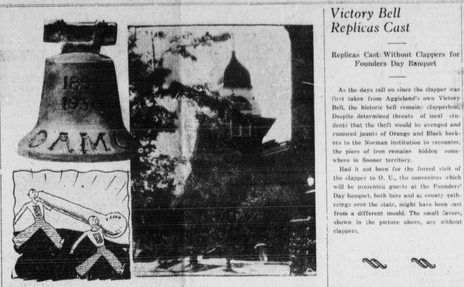
1930 OAMC Old Central clay pottery victory bell, 4 inches tall.
In 1930, Dr. Bennett had the university foundry produce replicas of Old Central's Victory Bell to give as mementos at the annual Founder's Day banquet. They were able to produce only a fraction of the amount of bells that were needed, therefore attendees had to specifically request the bells and return to Stillwater at a later date if they wished to receive one.
Of note is that these bells were made weeks after the controversial and historical theft of Old Central's bell clapper by OU students. The Sooner students wished to prevent the Victory Bell from ringing upon their football loss to OAMC in 1930. Therefore, these bells were cast without a clapper inside. Alas, Aggie lettermen went to Norman and were able to reclaim the clapper shortly after the season ended. For a number of years the clapper was the symbol of the gridiron rivalry, and the winner would get to keep the clapper as a year-long trophy of the most recent victory. Eventually that tradition waned, but today the universities still compete each year for the Bedlam Bell, which has its origins in this story. The above clipping is from a early December 1930 O'Collegian newspaper.
In 1930, Dr. Bennett had the university foundry produce replicas of Old Central's Victory Bell to give as mementos at the annual Founder's Day banquet. They were able to produce only a fraction of the amount of bells that were needed, therefore attendees had to specifically request the bells and return to Stillwater at a later date if they wished to receive one.
Of note is that these bells were made weeks after the controversial and historical theft of Old Central's bell clapper by OU students. The Sooner students wished to prevent the Victory Bell from ringing upon their football loss to OAMC in 1930. Therefore, these bells were cast without a clapper inside. Alas, Aggie lettermen went to Norman and were able to reclaim the clapper shortly after the season ended. For a number of years the clapper was the symbol of the gridiron rivalry, and the winner would get to keep the clapper as a year-long trophy of the most recent victory. Eventually that tradition waned, but today the universities still compete each year for the Bedlam Bell, which has its origins in this story. The above clipping is from a early December 1930 O'Collegian newspaper.
Other OAMC Items
Hickok belt buckle featuring the Oklahoma A&M Tiger mascot. Oklahoma State traces its colors and original mascot back to it's emulation of Princeton. While the Tiger was the official mascot for the first several decades, it was unpopular with fans of the school. Instead, they opted to be referred to as Agriculturists or Aggies. Thus, Tiger items are extremely scarce.
